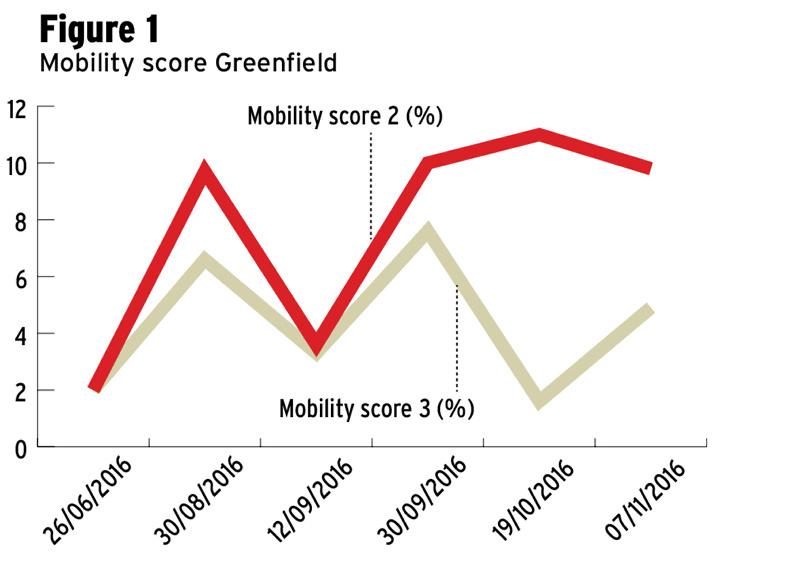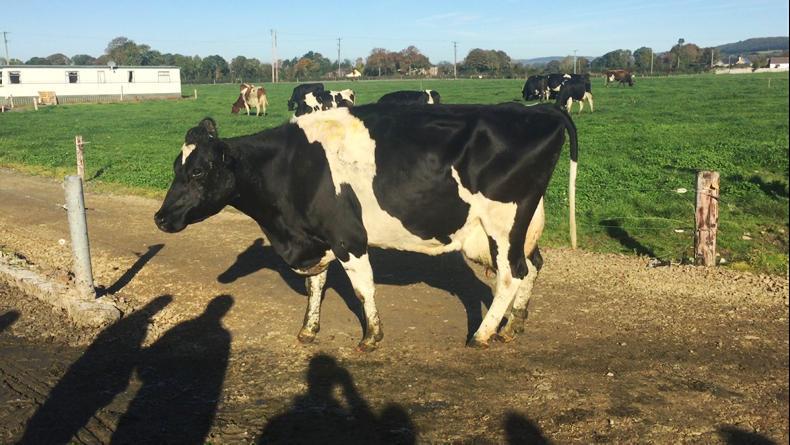The separate herd for lame cows in Greenfield has been running at between 15 and 20 cows all year. With 336 cows being milked for most of this year, this means about 6% of the cows were lame at any one time.
The issues in Greenfield are similar to the issues experienced on many other farms. As herd size increases, cows need to walk further distances to get to the cow paddocks. The cow paddocks are also bigger as there are more cows in the herd so they spend more time walking to and from water troughs or to the backs of paddocks.
The cows in Greenfield spend on average 1.3 hours a day walking. Over the course of a year, they walk over 1,200 kilometres.
With so much walking, the focus must be on breeding cows that are robust and up for the challenge. But the surfaces cows are walking on and how lameness is managed are key also. A lot of the things you can get away with in a smaller herd you cannot get away with in larger herds.
All the roadways in Greenfield were constructed from scratch when the farm was converted to dairy in 2009. Foundations were installed under the sections of the roads nearest the milking parlour by clearing away the topsoil, but the stone was placed on the topsoil for the further away sections of road.
Since being installed in 2010, about €18,000 has been spent on upgrading and improving the roadways since 2010. Most of this was spent on buying and laying blinding and fines on the surface as the finish on the first roads was considered too rough. A further €7,000 was spent this September on stone for the 0.6km of track nearest the parlour that gets most traffic.
Workshop
Abigail Ryan held a workshop on lameness on the Greenfield farm in October. One of the key outcomes was the importance of road surfaces and managing lameness through mobility scoring.
“We need to manage lameness like we manage somatic cell count. We milk-record and treat high-SCC cows based on the results and now we have taken the same approach towards managing lameness. We mobility-score the herd every month and manage cows based on the results,” Abigail said.
So what’s involved in mobility scoring? Noel Byrne from Moorepark explained that it is putting a score on how each cow is walking. A cow walking perfectly is given a score of 0, while a cow walking almost perfectly is given a score of 1. A very lame cow is given a score of 3, while cows showing early signs of lameness are given a score of 2.
“The real purpose of mobility scoring is to identify the cows that score 2. Everyone can spot a 3 because she is obviously lame, but if you treat a cow when she’s a 2 before she develops into a 3 then you will be making real progress in tackling lameness,” Noel said.
Noel was involved in the Healthy Genes trial last year, where 11,380 cows on commercial farms were mobility-scored. At the start of the year, 4% of the cows had a mobility score of 2 or greater, but as the year went on this figure increased to almost 7%.
“Over 8,000 cows had their feet pared to look for signs of injury or disease and in the vast majority of cases the problems were caused by injuries when something mechanical, usually a stone entered the hoof causing drops or ulcers. Diseases like Mortellaro were very rare,” Noel said.
Ideally, cows to be mobility-scored should be walking on a smooth and level surface and at their own pace and should be assessed from the side, or at least at a slight angle to the cow so you can see her from the side and from the back.
The problem is, to record a cow’s number and give her a mobility score at the same time is difficult to do. In Greenfield, they bring all the cows into the collecting yard and put them through the crush. Their tag numbers are recorded in the crush and then they are scored as they walk out and away from the crush. The cow’s number and what score she was given is recorded on paper.
While it is only cows with a mobility score of 2 and 3 that are being treated, it is important to record all the cows so you can track changes over time.
Cows are ten times more likely to get lame in autumn than spring
As was shown in the Healthy Gene study, incidences of lameness increase as you move into lactation. Cows are ten times more likely to get lame in autumn than spring. This is because the sole horn of the hoof wears down and becomes thinner, making it soft and easier for stones to penetrate. Cows walking long distances will wear their sole sooner, just like with a pair of shoes.
Ideally, the sole horn should be ¼ inch thick, but in late lactation it can be much thinner. Prolonged wet weather, where cows are eating low dry matter grass and walking on wet surfaces will also make the sole softer.
Considering the Irish weather and calving patterns, it’s inevitable that sole horns are going to get soft in autumn, so the focus must be on providing roadways that are smooth and free of stones. Reducing sharp turns on concrete will help also, as this puts a lot of pressure on the inside claws, where most lameness problems occur as they carry more weight.
Since they started mobility scoring in Greenfield back in June, the number of cows with mobility scores of 2 and 3 has fluctuated but the number of cows that are severely lame has decreased with less than 5% score 3 last week. See Figure 1 for the trends in mobility score.
Farm manager Tom Lyng has recently done a hoofparing course which will allow for earlier treatment of cows with a mobility score of 2.

Watch: how to carry out hoof trimming
Full coverage: lameness






 This is a subscriber-only article
This is a subscriber-only article













SHARING OPTIONS: